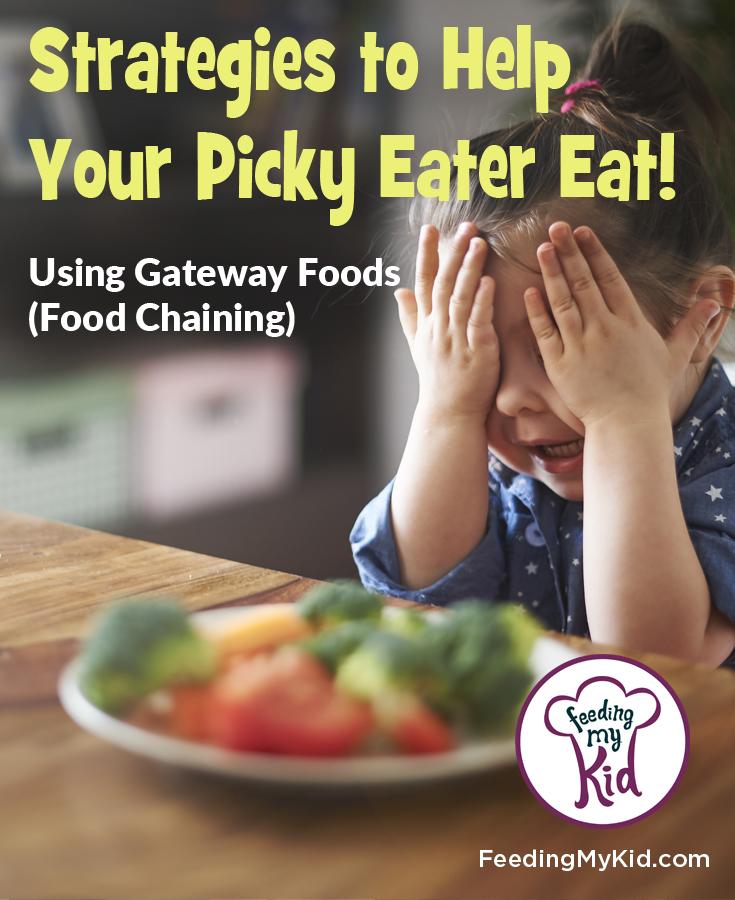 There are a number of reasons why your child might be a picky eater. Check out the article The Science Behind Picky Eating to find out why some kids are picky eaters and some are not. One of the best ways to expand your child’s palate is to ensure your child is exposed to a large variety of foods.
There are a number of reasons why your child might be a picky eater. Check out the article The Science Behind Picky Eating to find out why some kids are picky eaters and some are not. One of the best ways to expand your child’s palate is to ensure your child is exposed to a large variety of foods.
We are all creatures of habit, including our kids. Picky eating for many kids becomes a vicious cycle of not eating certain foods, so parents start to offer the foods they know their child will eat and then the kids become even more inclined to only eat these foods. The cycle repeats and further deepens a child’s comfort level with certain foods and rejecting all other foods.
In this article, we are going to discuss one strategy to help your picky eater expand their palate and transition from eating a small variety of foods into being more open to trying new foods.
Using Gateway Foods is a strategy you can start tomorrow which can dramatically help your child expand on the amount of variety he or she eats on a regular basis.
What Are Gateway Foods (Food Chaining)?
Gateway foods, also known as food chaining, is a child-friendly approach to help your child accept foods; by slowing building on the food your child is currently eating.
The first step is to identify and document all the foods your child is already eating. This is going to be your base of foods you will start with. This is an important step! You may even be surprised by the amount of foods your child is eating. You may even feel a sense of relief by writing out all the foods your child is eating.
It may take you a few days to write down all the different types of foods your child is eating. We have created this printout to help you along the way.
Watch this video on how to use the Gateway Food Tracker Chart to track your child’s progress.
How To Count Food?
If your child eats mashed potatoes, French Fries and tater tots, then count that as three separate items on your list. Even though your child is eating the same potato, the preparation is very different, so it counts as three separate foods. If your child eats a variety of cookies and candies, write those down too. Does your child eat raw carrots and baked carrots? Write these as two different foods.
If your child is eating less than 20 foods, then I highly recommend you speak with a Feeding Specialist in your area. The Therapist may still recommend food chaining for your child, but your child needs to go through the different steps slower than a child who eats a larger variety of foods.
I recommend you go at your child’s pace and do your best not to show your frustration during this process. Getting kids to do something different can be difficult and that goes for adults too 😉
How To Build On Your Child’s Foods?
I use the example of French Fries in the video. Let’s say your child is a huge fan of French Fries. I recommend you try offering your child sweet potato fries, and then other root vegetables in fry shape. If your child isn’t open to trying other vegetables cut into fry shapes, then see if your child will be open to eating potato fries cut into a variety of shapes like waffle fries, steak fries, wedges, crinkle cut, shoestring string and tater tots. Once your child accepts a new food, mark it off in the Gateway Food Tracker Chart with a happy face and keep building on each success. You have just expanded the foods your child eats! It’s a win!
If your child eats chicken nuggets, try purchasing a different brand, but have it be similar to what your child is currently eating. If your child accepts it and eats it then start to transition your child to even more brands of chicken nuggets and then transition to breaded chicken breast. Some children will allow you to skip a bunch of step, while another child might need to transition very slowly between variations.
As your child accepts each new variation, keep progressing your child’s variety until they reach the food you want them to reach or the food they can tolerate. The goal is to transition your child off processed chicken nuggets to eating different cuts of a chicken.
The same goes for fish sticks. You ultimately want them to transition to any type of breaded fish to a variety of seafood prepared a number of different ways from breaded, grilled or seasoned.
What About Vegetables?
If your child doesn’t eat a lot of vegetables, you can use the Gateway Foods method to get your child to eat more veggies too. If your child likes breading, then try breading zucchini cut into fry shape and baking them to make zucchini fries. Check out our list of vegetable dippers to get ideas on how to prepare vegetables that are more in-line with your child’s allowable foods.
My Gateway Foods Success Story
For me, my twins did not like slimy foods, which meant most vegetables and fruits were off limits. I figured out my kids loved chips and pretzels pretty quickly. So, I started to build on the foods I knew they would eat. I would offer them vegetable chips, dehydrated vegetables, like these peas and a large variety of dehydrated fruit. I didn’t even know these things existed until I started my research on ways to get them to eat.
As my twins became more accustomed to eating the dehydrated strawberries, I started to introduce more and more slimy foods, aka fruits and vegetables. My twins started to associate that they were eating peas, corn, strawberries, even if they weren’t dehydrated. Eventually they just got it.
During this process, I started making two vegetables as my sides for lunch and dinner. My twins become used to seeing these foods on the table. At first they would flip out if I put these foods on their tray. It took a number of times before they would even tolerate allowing me to put these foods on their tray. I never forced them to take a bite or really encouraged them to eat the food. I was neutral. After countless more exposures and a lot of food being thrown on the ground, my twins would take a bite!
This became the new norm. I put some food on their trays and I am completely neutral if they eat it or don’t. I am constantly surprised when one of them is willing to try a new food that I have been exposing them to for months. Just the other day, it was a tomato. One of my kids finally ate a tomato! Check out the article, why teaching your kids to eat well is just as hard as teaching him or her to read.
Pitfalls to Avoid
Let your child set the pace for how quickly you can introduce new textures, preparations, flavors, etc. Some kids will be more open to these food transitions, while others will freak out! Before a child can eat the food, the child needs to be able to tolerate the food on the table and then on their plate. The child also needs to be ok with the smell of the food and the touch of it. It can take countless exposures before a child tries the food.
Try not to overwhelm your child with too many new food choices at once. It can be a slow transition.
You do not need to make every meal an opportunity for food chaining or using gateway foods.
Don’t make your child’s eating or lack of eating the focus of the meal. Talk about your day; make your mealtime a fun, social experience for your family.
Why It’s Important To Expand Your Child’s Food Preferences
According to an article, “Feeding Disorders in Infants and Children”, published in the scientific journal Pediatric Clinics of North America, between 25 to 35 percent of children in the United States have feeding disorders, and up to 40 to 70 percent of children with chronic medical problems have problems related to feeding and nutrition.
If a child is eating a small variety of foods, then the child can become deficient in certain nutrients and vitamins. If this goes on for too long then it can cause malnutrition, erratic sleeping patterns, oral aversion, congestion, fluctuating weight, as well as a host of frequent and chronic illnesses.
Variety is Good
The best advice I can give is to add a tremendous amount of variety to your child’s diet. Change up the flavors, textures, preparations and parings as often as you can. This will stop your child from getting in a food rut.
Download the Gateway Food Tracker Chart and get started on expanding the foods your child is eating.
Also, check out our next recommendations for helping your child go from picky eating to adventurous foodie, called the Rotation Rule. It’s an easier strategy to implement than gateway foods, but we recommend you run both of these strategies at the same time. This increases your exposure opportunities.

